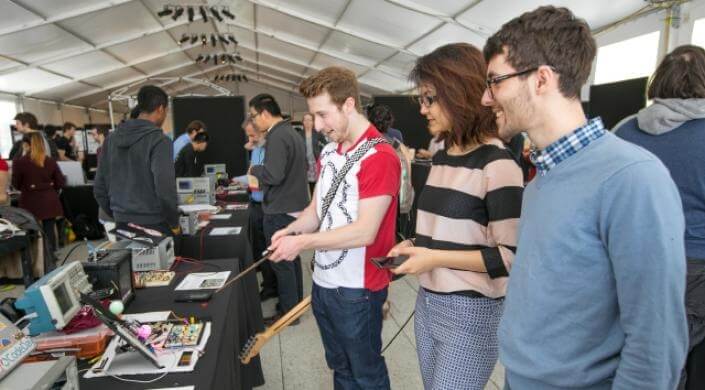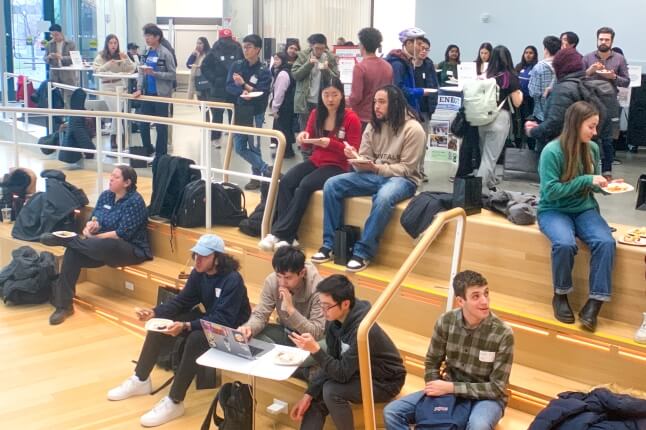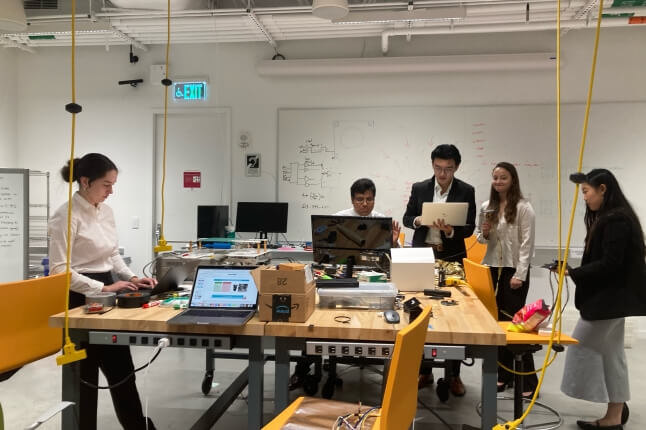News
Computer science concentrator Lev Grossman, A.B. '20, tests out the Harry Potter-inspired game developed by Nicole Flett, S.B. ’18, an electrical engineering and East Asian studies concentrator, and Raphael Rouvinov, A.B. ’19, a computer science concentrator, for The Joy of Electronics (ES 52). (Photo by Eliza Grinnell/SEAS Communications.)
Science fiction writer Sir Arthur Charles Clarke once said, “Any sufficiently complicated technology is indistinguishable from magic.” If that’s the case, then there was plenty of student-developed “magic” on display at the sixth annual Harvard John A. Paulson School of Engineering and Applied Sciences (SEAS) Design and Project Fair on May 3.
The magical world of Harry Potter inspired the engineering project developed by Nicole Flett, S.B. ’18, an electrical engineering and East Asian studies concentrator, and Raphael Rouvinov, A.B. ’19, a computer science concentrator. The game they designed incorporates a laser pointer onto a magic wand (a souvenir Flett picked up during a trip to Universal Studios), which aspiring “wizards” use to shoot sensor-based light-up targets embedded inside Ping-Pong balls.
“Getting each component of this project to work together seamlessly was a real challenge,” Flett said. “We drew on the skills we learned in many different courses and labs. It is very cool to understand how all these parts work together.”
The project, which the team developed for The Joy of Electronics (ES 52), was one of about 75 featured projects under the Science Center Plaza tent at the annual SEAS showcase of student design and engineering acumen.
More Harry Potter-themed “magic” was on display a few tables over, where Jesse Thue, A.B. ’20, and James Jones, S.B. ’19, an engineering sciences – environmental engineering concentrator, demonstrated an enhanced scoring hoop for Quidditch, a sport featured in the book and movie series where teams of broomstick-riding players, flying high above the ground, score points by throwing balls through tall hoops. Thue and Jones, members of the Harvard Horntails (a club Quidditch team that competes nationally in a ground-based version of the sport) developed the hoop for ES 52 to solve scorekeeping problems commonly encountered during high-speed matches.
A sensor placed inside a volleyball illuminates infrared LEDs on the rim of the hoop when the ball passes through; each point is then automatically recorded on an attached scoreboard display. The hoop also features passive touch fabric, so when a player taps a hoop to tag back into the game, lights notify referees.
“Because it is so hard to detect when a ball has gone through a hoop, oftentimes goals are disputed during a match,” Thue said. “This would make scoring a lot more reliable.”
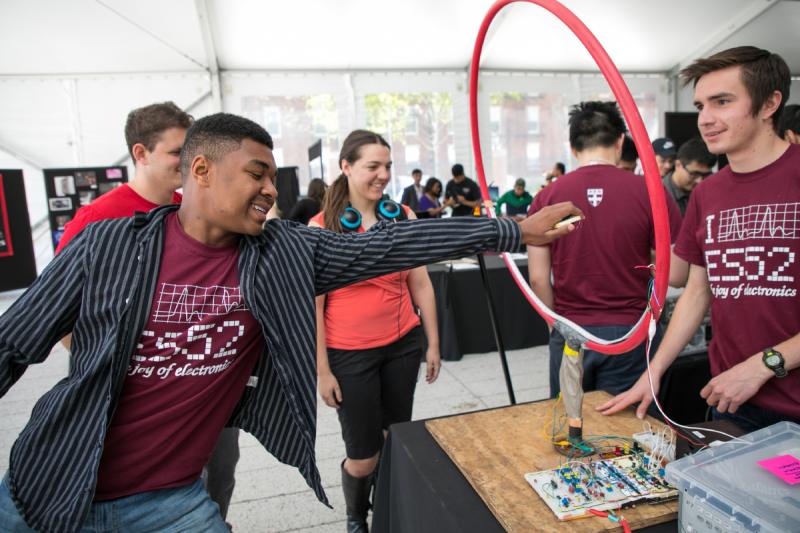
James Jones, S.B. ’19, an engineering sciences – environmental engineering concentrator (left), demonstrates the enhanced Qudditch scoring hoop he and teammate Jesse Thue, A.B. ’20 developed. (Photo by Eliza Grinnell/SEAS Communications.)
Theirs was one of many featured projects that sought to solve problems. For instance, four students created a mobile app for Design of Useful and Usable Interactive Systems (CS 179) to help visually impaired individuals follow recipes and prepare meals.
The mobile app, called Sous Chef, reads the ingredients, measurements, and steps of a recipe, and also incorporates computer vision tools to help during the cooking process. An individual holds a phone camera up to a bowl of pancake batter, for example, and algorithmic tools determine if it has reached the correct consistency. A bar code scanner also enables the app to read aloud ingredients and nutrition facts on packaged foods.
“A lot of mobile apps that are developed to make life easier are not designed for people who are visually impaired,” said Vinay Iyengar, A.B. ’18, a computer science concentrator. “This is really about advocacy and activism for a population that often doesn’t have much of a voice in world of high-tech products.”
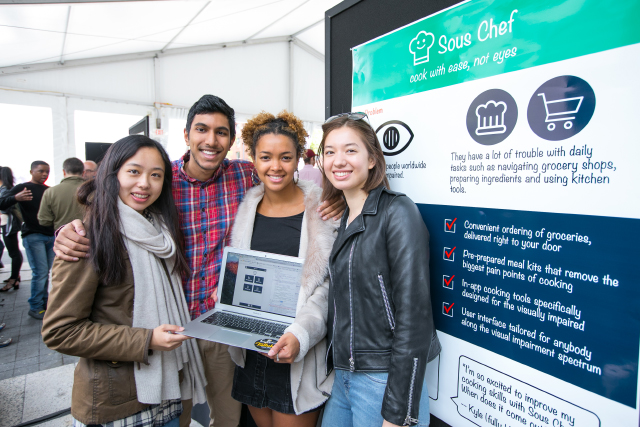
Students (from left) Jocelyn Fu, A.B. '17, an applied math concentrator, Vinay Iyengar, A.B. '18, a computer science concentrator, Tallulah Axinn, A.B. '18, an applied math concentrator, and Maria Lovett, A.B. '17, a computer science concentrator, developed a mobile app to help visually impaired individuals follow recipes and prepare meals. (Photo by Eliza Grinnell/SEAS Communications.)
While other projects tackled thorny issues like helping immigrants access legal services or monitoring air pollution in the Amazon rainforest, some were purely for fun, like the electric guitar built by Paul Lisker, A.B. ’17, a computer science concentrator, for Computational Music Theory (AM 141).
Lisker learned the value of thorough planning and design as he crafted the guitar body out of mahogany and incorporated magnets, wires, and strings to create the electrical pulses an amplifier converts to sound.
“I’ve played guitar for several years, but I never appreciated the steps that go into designing and building one,” he said. “If the neck was off by even a tiny angle, for instance, the intonation would be completely wrong.”
Lisker then launched into a melodious rendition of the Red Hot Chili Pepper’s “Under the Bridge,” highlighting the satisfaction of a job well done, and for him and his peers, the harmonious conclusion of the academic year.
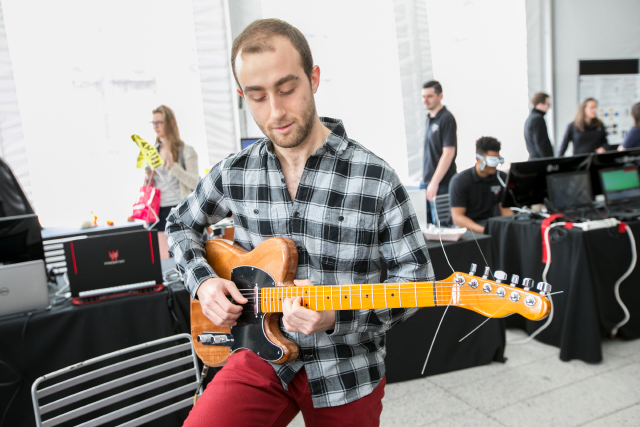
Building this electric guitar taught computer science concentrator Paul Lisker, A.B. '17, a great deal about the value of thorough planning and design. (Photo by Eliza Grinnell/SEAS Communications.)
Topics: Academics
Cutting-edge science delivered direct to your inbox.
Join the Harvard SEAS mailing list.
Press Contact
Adam Zewe | 617-496-5878 | azewe@seas.harvard.edu
